Analys
US shale oil production growth slowing sharply


The US EIA yesterday released its monthly drilling and productivity data. It showed that US shale oil production is slowing down even faster than they assumed just one week ago in their monthly STEO oil market outlook. All through 2019 we have seen an ongoing sharp decline in drilling. The slowdown in production growth has however been much more muted as producers have been able to tap a large inventory of drilled but uncompleted wells (DUCs). The well-completion rate has been holding out at around 1350 to 1400 wells per month but now it suddenly fell off a cliff in November.

The number of usable wells in the DUC inventory has always been highly uncertain. We had expected the well-completion rate to hold out at around 1350 to 1400 until Feb/Mar next year before producers would be forced to reduce the completion rate in lack of usable wells in the DUC inventory. But now it is happening already in November. This could be noise, or it could be a sign that number of useful wells in the DUC inventory are fewer than expected.
Losses in existing production is still on the rise while new monthly production is in decline as fewer wells are completed. US shale oil production is now projected to grow by only 30 k bl/d in January (360 k bl/d annualized rate) and it is rapidly moving towards zero growth. If the well completion rate falls another 50-100 wells, we’ll have zero production growth in US shale oil production. Last week the US EIA projected that US shale oil production will be in contraction at the end of 2020 but still hold out at a 50 k bl/d production growth rate MoM through the first five months of 2020. Yesterday’s drilling and productivity data is probably indicating that these assumptions are too high, and that production is slowing down even faster than projected just one week ago. Our view is still that the US EIA is estimating drilling productivity at too high a level because the DUC inventory is being drawn down and thus crates an image of high production per drilling rig in operation.
In a nutshell the number of drilled wells went down by 79 wells, completed wells went down by 155, the DUC inventory declined by 131 wells, production growth fell in 5 out of 7 regions with only one region slightly higher and one unchanged. Non-Permian production will decline by 18 k bl/d MoM in January (216 k bl/d annualized decline rate) and total US shale oil production will only grow by 30 k bl/d in January (360 k bl/d annualized rate).
Across the raw material space, the mantra today is “profit, not volume”, so also in shale oil. It is lack of profitability which is driving down the activity in US shale oil production. It is not lack of ability to produce.
Yesterday’s data and reports from the US EIA is truly great reading for OPEC+. It makes the task of controlling the supply/demand balance in the global oil market next year so much easier. Rather than US shale oil flooding into the market at an increasing rate it is now instead rapidly moving towards zero growth. That makes it much more controllable for OPEC+.
The great thing about US shale oil seen in the eyes of OPEC is the sharp underlying decline rate. OPEC can at any time get back its lost market share probably within a year or so. All it needs to do is to let the oil price drop down deep for 6-12 months. US shale oil production would crash, demand would boom on low prices and voila OPEC’s market share would be back to normal.
So, in terms of market share OPEC has nothing to worry about. It can easily and quickly get it back again anytime it wants to. This would not have been the case if the new oil supply in the US had been more like classic oil which typically never goes away before 10 years or more have passed. A lower price would of course be the price to pay for getting back the lost market share. But time of getting it back would be quick.
Ch1: The number of completed shale oil wells in the US fell off a cliff in November. Much sooner than expected.
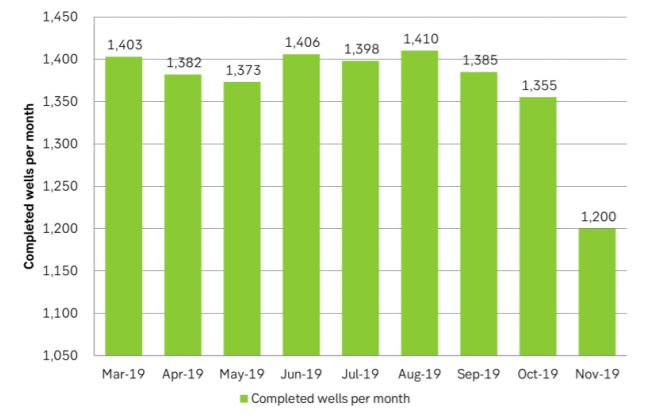
Ch2: If US shale oil producers reduce the number of completed wells by another 58 wells then US shale oil production will have zero growth in January rather than a projected growth rate of 30 k bl/d MoM as projected by the US EIA yesterday

Ch3: The US EIA is over-estimating the drilling productivity due to the DUC inventory draw
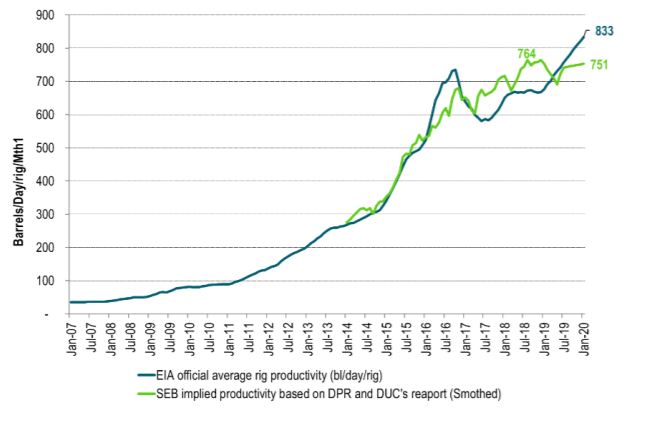
Ch4: The US shale oil DUC inventory is drawing down. We had expected that the draw down rate should accelerate with the DUC inventory then bottoming out at around 5,500 where it bottomed out last time. But the draw down slowed in November. Lack of good wells in the DUC inventory?
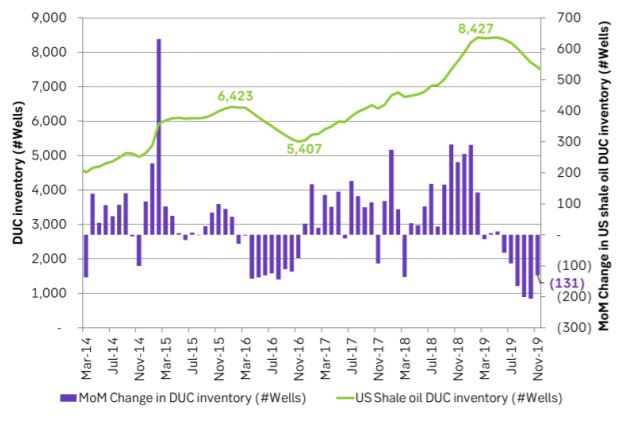
Ch5: SEB well productivity estimate
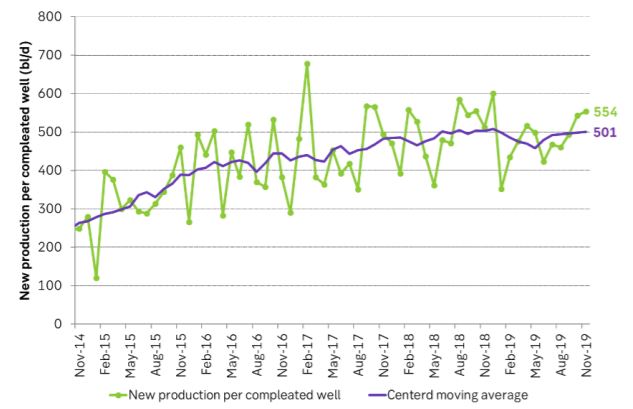
Ch6: The productive value of drilled wells has fallen for a long time as the number of drilled wells per month has declined along with a lower drilling rig count. New in November was that the completion rate also declined sharply. It was bound to happen sooner or later but now it happened sooner.
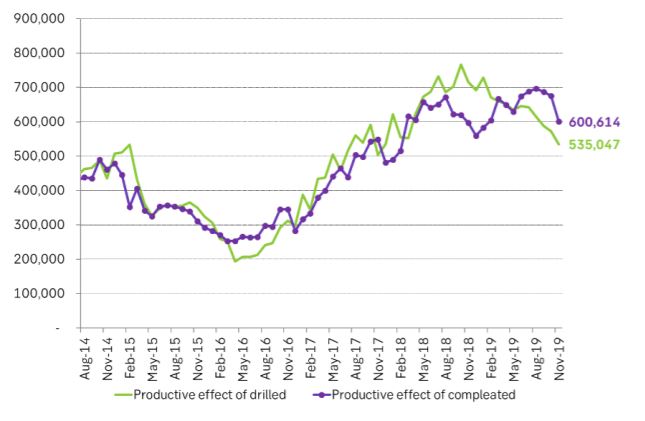
Ch7: Losses in existing production continued to rise while new production is declining. When they meet overall production growth will be zero and then rapidly decline as new production goes below losses in existing production. It’s like breaking off a stick in terms of production. That’s what we saw back in early 2015.

Ch8: US production growth is slowing down. Non-Permian shale oil production is now in decline by a marginal, annualized rate of 216 k bl/d/yr.
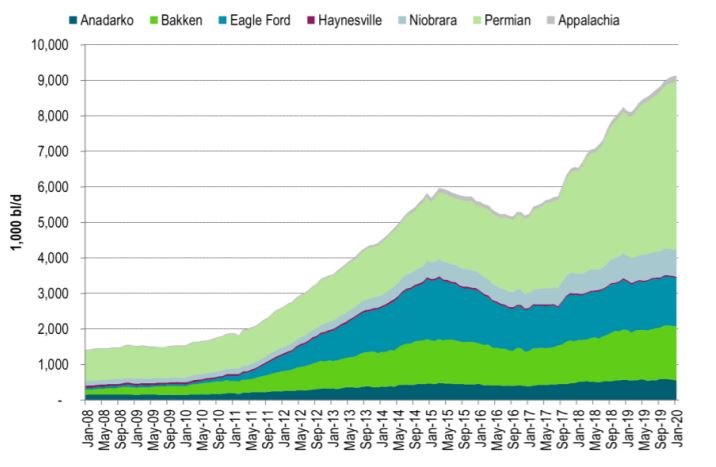
Analys
Tightening fundamentals – bullish inventories from DOE

The latest weekly report from the US DOE showed a substantial drawdown across key petroleum categories, adding more upside potential to the fundamental picture.

Commercial crude inventories (excl. SPR) fell by 5.8 million barrels, bringing total inventories down to 415.1 million barrels. Now sitting 11% below the five-year seasonal norm and placed in the lowest 2015-2022 range (see picture below).
Product inventories also tightened further last week. Gasoline inventories declined by 2.1 million barrels, with reductions seen in both finished gasoline and blending components. Current gasoline levels are about 3% below the five-year average for this time of year.
Among products, the most notable move came in diesel, where inventories dropped by almost 4.1 million barrels, deepening the deficit to around 20% below seasonal norms – continuing to underscore the persistent supply tightness in diesel markets.
The only area of inventory growth was in propane/propylene, which posted a significant 5.1-million-barrel build and now stands 9% above the five-year average.
Total commercial petroleum inventories (crude plus refined products) declined by 4.2 million barrels on the week, reinforcing the overall tightening of US crude and products.


Analys
Bombs to ”ceasefire” in hours – Brent below $70

A classic case of “buy the rumor, sell the news” played out in oil markets, as Brent crude has dropped sharply – down nearly USD 10 per barrel since yesterday evening – following Iran’s retaliatory strike on a U.S. air base in Qatar. The immediate reaction was: “That was it?” The strike followed a carefully calibrated, non-escalatory playbook, avoiding direct threats to energy infrastructure or disruption of shipping through the Strait of Hormuz – thus calming worst-case fears.

After Monday morning’s sharp spike to USD 81.4 per barrel, triggered by the U.S. bombing of Iranian nuclear facilities, oil prices drifted sideways in anticipation of a potential Iranian response. That response came with advance warning and caused limited physical damage. Early this morning, both the U.S. President and Iranian state media announced a ceasefire, effectively placing a lid on the immediate conflict risk – at least for now.
As a result, Brent crude has now fallen by a total of USD 12 from Monday’s peak, currently trading around USD 69 per barrel.
Looking beyond geopolitics, the market will now shift its focus to the upcoming OPEC+ meeting in early July. Saudi Arabia’s decision to increase output earlier this year – despite falling prices – has drawn renewed attention considering recent developments. Some suggest this was a response to U.S. pressure to offset potential Iranian supply losses.
However, consensus is that the move was driven more by internal OPEC+ dynamics. After years of curbing production to support prices, Riyadh had grown frustrated with quota-busting by several members (notably Kazakhstan). With Saudi Arabia cutting up to 2 million barrels per day – roughly 2% of global supply – returns were diminishing, and the risk of losing market share was rising. The production increase is widely seen as an effort to reassert leadership and restore discipline within the group.
That said, the FT recently stated that, the Saudis remain wary of past missteps. In 2018, Riyadh ramped up output at Trump’s request ahead of Iran sanctions, only to see prices collapse when the U.S. granted broad waivers – triggering oversupply. Officials have reportedly made it clear they don’t intend to repeat that mistake.
The recent visit by President Trump to Saudi Arabia, which included agreements on AI, defense, and nuclear cooperation, suggests a broader strategic alignment. This has fueled speculation about a quiet “pump-for-politics” deal behind recent production moves.
Looking ahead, oil prices have now retraced the entire rally sparked by the June 13 Israel–Iran escalation. This retreat provides more political and policy space for both the U.S. and Saudi Arabia. Specifically, it makes it easier for Riyadh to scale back its three recent production hikes of 411,000 barrels each, potentially returning to more moderate increases of 137,000 barrels for August and September.
In short: with no major loss of Iranian supply to the market, OPEC+ – led by Saudi Arabia – no longer needs to compensate for a disruption that hasn’t materialized, especially not to please the U.S. at the cost of its own market strategy. As the Saudis themselves have signaled, they are unlikely to repeat previous mistakes.
Conclusion: With Brent now in the high USD 60s, buying oil looks fundamentally justified. The geopolitical premium has deflated, but tensions between Israel and Iran remain unresolved – and the risk of missteps and renewed escalation still lingers. In fact, even this morning, reports have emerged of renewed missile fire despite the declared “truce.” The path forward may be calmer – but it is far from stable.
Analys
A muted price reaction. Market looks relaxed, but it is still on edge waiting for what Iran will do

Brent crossed the 80-line this morning but quickly fell back assigning limited probability for Iran choosing to close the Strait of Hormuz. Brent traded in a range of USD 70.56 – 79.04/b last week as the market fluctuated between ”Iran wants a deal” and ”US is about to attack Iran”. At the end of the week though, Donald Trump managed to convince markets (and probably also Iran) that he would make a decision within two weeks. I.e. no imminent attack. Previously when when he has talked about ”making a decision within two weeks” he has often ended up doing nothing in the end. The oil market relaxed as a result and the week ended at USD 77.01/b which is just USD 6/b above the year to date average of USD 71/b.

Brent jumped to USD 81.4/b this morning, the highest since mid-January, but then quickly fell back to a current price of USD 78.2/b which is only up 1.5% versus the close on Friday. As such the market is pricing a fairly low probability that Iran will actually close the Strait of Hormuz. Probably because it will hurt Iranian oil exports as well as the global oil market.
It was however all smoke and mirrors. Deception. The US attacked Iran on Saturday. The attack involved 125 warplanes, submarines and surface warships and 14 bunker buster bombs were dropped on Iranian nuclear sites including Fordow, Natanz and Isfahan. In response the Iranian Parliament voted in support of closing the Strait of Hormuz where some 17 mb of crude and products is transported to the global market every day plus significant volumes of LNG. This is however merely an advise to the Supreme leader Ayatollah Ali Khamenei and the Supreme National Security Council which sits with the final and actual decision.
No supply of oil is lost yet. It is about the risk of Iran closing the Strait of Hormuz or not. So far not a single drop of oil supply has been lost to the global market. The price at the moment is all about the assessed risk of loss of supply. Will Iran choose to choke of the Strait of Hormuz or not? That is the big question. It would be painful for US consumers, for Donald Trump’s voter base, for the global economy but also for Iran and its population which relies on oil exports and income from selling oil out of that Strait as well. As such it is not a no-brainer choice for Iran to close the Strait for oil exports. And looking at the il price this morning it is clear that the oil market doesn’t assign a very high probability of it happening. It is however probably well within the capability of Iran to close the Strait off with rockets, mines, air-drones and possibly sea-drones. Just look at how Ukraine has been able to control and damage the Russian Black Sea fleet.
What to do about the highly enriched uranium which has gone missing? While the US and Israel can celebrate their destruction of Iranian nuclear facilities they are also scratching their heads over what to do with the lost Iranian nuclear material. Iran had 408 kg of highly enriched uranium (IAEA). Almost weapons grade. Enough for some 10 nuclear warheads. It seems to have been transported out of Fordow before the attack this weekend.
The market is still on edge. USD 80-something/b seems sensible while we wait. The oil market reaction to this weekend’s events is very muted so far. The market is still on edge awaiting what Iran will do. Because Iran will do something. But what and when? An oil price of 80-something seems like a sensible level until something do happen.
-

 Nyheter4 veckor sedan
Nyheter4 veckor sedanUSA slår nytt produktionsrekord av naturgas
-

 Analys4 veckor sedan
Analys4 veckor sedanAll eyes on OPEC V8 and their July quota decision on Saturday
-

 Nyheter3 veckor sedan
Nyheter3 veckor sedanStor uppsida i Lappland Guldprospekterings aktie enligt analys
-

 Nyheter3 veckor sedan
Nyheter3 veckor sedanBrookfield ska bygga ett AI-datacenter på hela 750 MW i Strängnäs
-

 Nyheter4 veckor sedan
Nyheter4 veckor sedanSommaren inleds med sol och varierande elpriser
-

 Nyheter4 veckor sedan
Nyheter4 veckor sedanOPEC+ ökar oljeproduktionen trots fallande priser
-

 Nyheter3 veckor sedan
Nyheter3 veckor sedanSilverpriset släpar efter guldets utveckling, har mer uppsida
-

 Analys4 veckor sedan
Analys4 veckor sedanBrent needs to fall to USD 58/b to make cheating unprofitable for Kazakhstan









